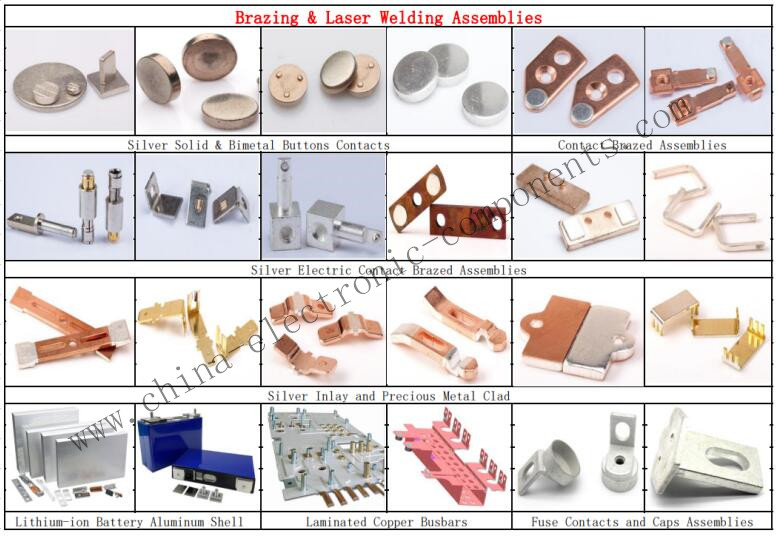The basic principle of Silver Electric Contact resistance brazing is the same as that of resistance welding. It is a brazing method that uses electric current to pass through the weldment or the resistance heat generated by the contact block with the weldment to heat the weldment and melt the solder. When brazing spot welding, a certain pressure should be applied to the brazing part. This method has the advantages of rapid heating, high productivity, little effect of heating concentration on the surrounding heat, simple process, good labor conditions, and easy automation of the welding process. However, the size of the brazed joint should not be too large and the shape should not be too complicated, that is to say, this brazing method is limited by the shape and size of the joint.
According to different heating methods, resistance brazing is divided into direct heating method and indirect heating method. In direct heating resistance brazing, the two electrodes press the brazing part of the two parts, and the current flows through the brazing surface to form a loop, which is heated to the brazing temperature by the resistance heat generated in the brazing surface and the adjacent base metal. Its characteristics are that the heating is fast and concentrated at the brazing place, and the brazing surfaces are required to keep close contact with each other, otherwise, due to poor contact, the base metal will be partially overheated or the joints will be severely unbrazed and other defects. When the flux must be used, it should be used in the form of a solution with water or alcohol, and the use of solid flux should be avoided as much as possible, otherwise the heating of the brazing will be affected because it is not conductive.
In indirect heated resistance brazing Silver brazing products, the current passes through only one part, or not through the weldment at all. For the former, the melting of the solder and the heating of another part are achieved by the heat transfer of the electrically heated parts to them; as for the latter, the current is passed through a larger graphite plate or heat-resistant alloy plate, and the weldment is as far as this On the board, all rely on heat conduction to achieve brazing Weld rivet contact . Since the current does not pass through the brazing surface, solid flux can be used, and the matching requirements for the brazing surface of the weldment can also be lower. However, in order to ensure the assembly accuracy and speed up the heat conduction process, the butt welds still need to be pressed. The advantage of this method is to compare the brazing of materials with large differences in physical properties or weldments with greatly different thicknesses, and the heating center will not deviate from the front. However, the heating speed of this method is slow, and it is suitable for brazing of small pieces.
In general, the solder for resistance brazing Custom Brazed Composite Rivet Electrical Contacts can be powder, paste, foil and filament. Among them, the foil solder is the most ideal, and it can be conveniently placed directly between the brazing surfaces of the parts. Another method is to pre-coat the solder layer on the hybrid brazing surface, which is also the most common process measure and is widely used in the electronics industry. If a solder wire is used, after the brazing surface is heated to the brazing temperature, the end of the solder wire should be close to the gap of the brazing seam until the solder melts, fills the gap, and makes all edges appear flat.
The application of resistance brazing Composite Weld Contacts is still relatively wide, and the economic effect is the best when the area of the brazed joint is 65-380mm2. It is especially suitable for brazing of some weldments that do not allow integral heating. It is most suitable for brazing copper. It can be used for brazing silver alloy, copper alloy, steel and cemented carbide, etc. without flux. The low-voltage current can be applied to the weldment, and the resistance heat generated on the weldment can be directly heated, or the carbon electrode can be energized, and the resistance heat released by the carbon resistor can indirectly heat the weldment. The brazing materials used are copper-zinc, copper-phosphorus, silver-based, etc., which are commonly used in brazing tools, electrical contacts, motor electronic coils, instrument components and wire ends.

